#healthcare payment system
Explore tagged Tumblr posts
Text
.
#sorry let me rant real quick in the tags#cw personal#once again hitting an insurance pothole bc the psych says she accepts my OHP plan HOWEVER the therapy group she is contacted with says#THEY don't#they only accept the insurance if it's through my employer but NOT through the government??????????????#so there's still some kind of payment???#anyway I want to scream why is this so complicated#like will she take my insurance or not who's right here#anyway called her back directly and went to voicemail so now I've done all I can for now#why the hell is this so hard man#the person on the phone didn't know really how to explain#once again no one knows what they're talking about#like can y'all not communicate and figure this out?#AHHHHHHHHHHHHHHH#i need to get an ADHD eval before my next PCP appointment in june so that they will continue giving me my meds#and the psychiatry through the hospital has a limited number of visits that insurance will cover#*contracted#not retyping all of that#and once again the only reason this is so stressful is because the psychiatry group at the hospital fumbled the communication ball last tim#and the psychiatrist I was with never put the ADHD on the chart#and now somehow it's MY responsibility to fix that>#UGH#like I am grateful to have some kind of coverage but holy shit is the US healthcare system in shambles#the bureaucracy is INSANE#i had to just sit down and put my head in my hands for a second#and then go 'right okay nothing i can do about that rn moving on'#uGH#literally said 'what the FUCK' out loud a couple times#like not on the phone after I hung up obvs
14 notes
·
View notes
Text
I'm still here. Don't worry. It just feels like every bone in my body crumbled to dust.
Its fine.
Absooolutely fine.

i"M FINNNNE. ASK ME ANYTHING! - Grimsley
#(( the healthcare system is broken and I couldn't have my surgery. ))#(( So wonderful. Absolutely grand. ))#(( No payment plans allowed gotta fork over a grand upfront and I dont have it so I guess I JUST DIE hahhaaaaa ))#(( Everything is pain :') ))
5 notes
·
View notes
Text
“U eat like u have a healthcare system”…do people outside America actually think no one here can afford a hospital? I’m not defending how ungodly expensive our insurance and medical care prices are, but I’m sick of people thinking no one has insurance and access to a hospital. I’ve had insurance my whole life through my parents, and we were nowhere near rich. All my friends have insurance, all my extended family has insurance, and again, none of them are anywhere near rich.
“Americans believe in big portions! That’s so crazy.” Look at this European getting scammed into paying for 100 calories worth of food. Fool. Idiot. You wish you could have this 16 ounce Big Gulp and this serving of rice I will eat off for three days but you can’t. Cope and seethe.
#one more thing. stop thinking just because our payment system for healthcare is insane that our hospitals are bad#they’re not#it’s like thinking just because the student loan system is ludicrous that our universities are trash
115K notes
·
View notes
Text
#Choosing veterinary software#pet appointment booking India#Pet appointment software#Pet clinic booking software#Pet clinic payment processing#Pet clinic software#Pet clinic software India#Pet healthcare software#Pet management software#Top tips for veterinary software#vet appointment software#vet clinic software#Vet practice software India#Vet Software#Veterinary appointment booking#Veterinary appointment booking India#Veterinary Billing Software Suriname#Veterinary billing system#Veterinary clinic management software tips#veterinary clinic software#Veterinary clinic software India#Veterinary EMR software#veterinary management software#veterinary practice form#Veterinary practice management India#Veterinary Practice Management software#Veterinary Software
1 note
·
View note
Text
I just can not catch a break...
#another medical bill... plus school payment due#ya girl tries to help themselves and the Healthcare system screws me over#im gonna sadly eat my sandwich
1 note
·
View note
Text

Anviam Healthcare is a USA Based Medical Billing Organization that helps Healthcare Providers, such as Doctors, Hospitals, Clinics, and other Medical Facilities, to efficiently manage their Medical Billing and Claims Processing. Anviam Healthcare follow all these steps for payment posting workflow:
1. Receive payments:
Payments are received from insurance companies, patients, and other third-party payers.
2. Match payments to claims:
Payments are matched to the appropriate claims.
3. Verify payment amounts:
Payment amounts are verified to ensure that they match the amounts expected.
4. Post payments:
Payments are posted to the appropriate accounts and charges.
5. Reconcile discrepancies:
Any discrepancies are reconciled.
For More Info:-
you can visit: Anviam Healthcare
Contact us :
📞 +1-9175252370
🌐 www.anviamhealthcare.com
#anviamhealthcare#workflowmanagement#posting#payments#medicalbillingservices#medical billing company#payment solutions#medical billing outsourcing#medical billing agencies near me#medical billing and coding#healthcare#healthcaremanagement#healthcare professionals#medical coding#doctors#healthcare provider#us health system#healthcarebilling#healthcareindustry#healthcareworkers#healtcare
0 notes
Text
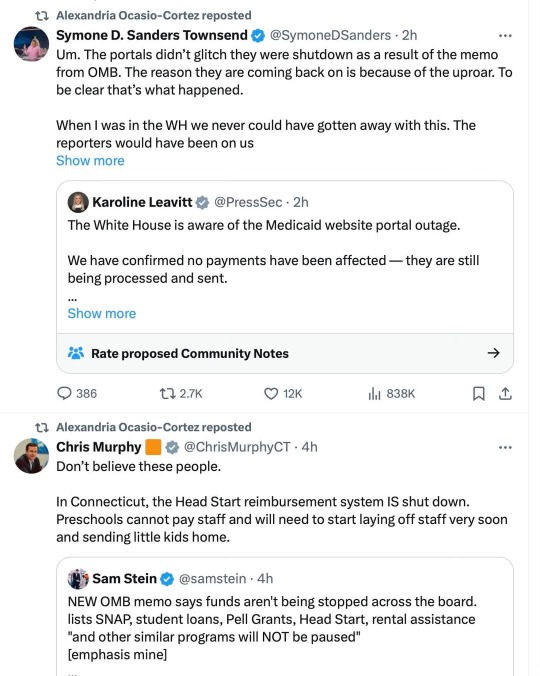
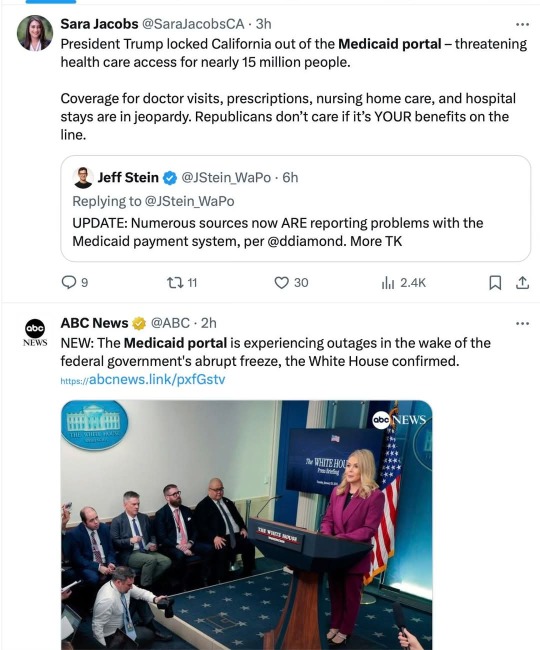

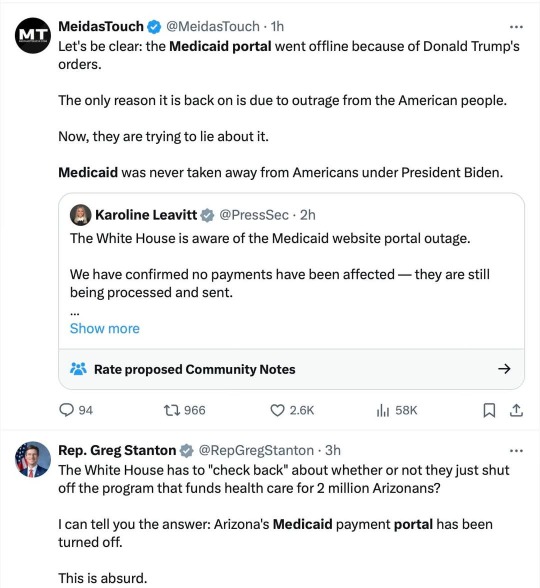
From Rebecca Solnit:
Yes, they want to steal your healthcare and rights and the rest for good, and they stole a lot of people's healthcare for the day. Also the White House press secretary seems to be lying about that. Don't buy the lies. Striking to see redder as well as bluer-state politicians in these tweets. And yeah, the attack is on hold BECAUSE of the huge pushback, but of course they're pretending they never intended this huge overreach.
It gets worse below the cut...
Martin Heinrich
@SenatorHeinrich
·
4h
Now Trump is blocking New Mexico's access to the Medicaid portal!
This won't just hurt the 714,422 New Mexicans on Medicaid. It threatens to shutdown our entire health care system.
I'm calling on Trump to undo this chaos IMMEDIATELY.
Rep. Nadler
@RepJerryNadler
·
1h
Make no mistake, this happened because Donald Trump ordered it to happen.
Many states still face Medicaid portal outages, and his reckless order continues to freeze critical services like food aid, cancer research, and FEMA relief—lifelines for Americans in every zip code.
Senator Beth Liston
@Liston4Ohio
·
1h
The Medicaid payment portal is currently frozen. Our healthcare system relies on these funds for over 3.5 million people. Hospitals, doctors, dentists - all providers are not getting paid. Ohio loses ~$73,000/minute if the federal government does not release the payments they owe
Rep. Terri A. Sewell
@RepTerriSewell
·
2h
My office has received reports that Alabama’s Medicaid portal is shut down.
More than 1 million Alabamians rely on Medicaid along with the providers, hospitals, & clinics that serve them.
The Trump Administration needs to restore it NOW!
Aaron Fritschner
@Fritschner
·
1h
Virginia civil servants are being placed on leave or fired, businesses and non-profits that rely on grants are preparing to close or lay off workers, the Medicaid portal is down, hospital funding is frozen, and all the Governor can muster is this blame-shifting twaddle? PATHETIC
Quote
Brandon Jarvis
@Jaaavis
·
2h
Youngkin’s statement on pause of federal grants
Image
Senator Chris Coons
@ChrisCoons
·
1h
Delaware's Medicaid payment portal was turned off, just like dozens of other states.
One in five Delawareans and nearly 80 million Americans are on Medicaid.
I don't know if this is cruelty or incompetence. I do know Trump is playing with people’s lives.
#rebecca solnit#us politics#dumpster fire usa#the week america was stripped for parts#christofascists#medicaid#us healthcare#us health system#we need luigis everywhere#antifascist
160 notes
·
View notes
Text
FEILD TRIP!!!!!!!!
(I promise it’s ok it’s been happening for years and I’m still kicking >:D my body cannot control ME)
@basically-bumble @officialtinder @incognito-mode-official @spotify-kids-real @wordswordsorswordswords @chaos-in-gv-anon @yes-im-youtube-kids @cars-official
We’re going to the hospital, do you guys want anything??? I’m snagging the free lollipops they normally reserve for kids :D
I love when I'm using my lungs for their intended purpose and they just start randomly bleeding
Mmmm my favorite
#GROCERY SHOPPING#YAYY FIELD TRIP#Time to go to the#Expensive Grocery Store#where they fix nothing and then ask for your house as payment#it’s my favorite game#don’t you love the American healthcare system#I SURE DO#gmail you are so sweet and precious#it’s very kind that you’re worried about everyone#hey hey#by any chance have you been adopted#just asking#for a friend#gmail#eharmony :DDDD#eharmony reblog
387 notes
·
View notes
Text
A comprehensive overview of Healthcare Payment Systems
In today's complex world of healthcare, one crucial component that is sometimes forgotten is the healthcare payment system. This complex network of processes and technologies is critical to ensure that healthcare providers receive timely and accurate reimbursement for their services. Understanding the complexities of healthcare payment systems is critical for healthcare professionals, administrators, and patients since they affect healthcare service delivery and cost.
Healthcare payment systems handle a wide range of tasks, including billing, reimbursement, and financial management. At their core, these systems are designed to facilitate the transfer of funds between patients, insurance companies, and healthcare providers. However, the difficulties of healthcare payment processing vary widely depending on factors such as insurance coverage, government regulations, and the type of healthcare service being provided.
One of the most difficult difficulties in healthcare payment processing is assuring accuracy and efficiency. Given the vast volume of transactions in the healthcare industry, even tiny errors or delays can have serious effects. Healthcare providers use sophisticated billing and coding systems to accurately document and submit claims for reimbursement. However, negotiating the complexities of insurance coverage and reimbursement requirements can be difficult, resulting in significant disparities and disagreements.
#healthcare payment system#healthcare payment systems#healthcare payment processing#healthare payment
0 notes
Text
The Best News of Last Week
1. ‘It was an accident’: the scientists who have turned humid air into renewable power
Greetings, readers! Welcome to our weekly dose of positivity and good vibes. In this edition, I've gathered a collection of uplifting stories that will surely bring a smile to your face. From scientific breakthroughs to environmental initiatives and heartwarming achievements, I've got it all covered.

In May, a team at the University of Massachusetts Amherst published a paper declaring they had successfully generated a small but continuous electric current from humidity in the air. They’ve come a long way since then. The result is a thin grey disc measuring 4cm across.
One of these devices can generate a relatively modest 1.5 volts and 10 milliamps. However, 20,000 of them stacked, could generate 10 kilowatt hours of energy a day – roughly the consumption of an average UK household. Even more impressive: they plan to have a prototype ready for demonstration in 2024.
2. Empty Office Buildings Are Being Turned Into Vertical Farms

Empty office buildings are being repurposed into vertical farms, such as Area 2 Farms in Arlington, Virginia. With the decline in office usage due to the Covid-19 pandemic, municipalities are seeking ways to fill vacant spaces.
Vertical farming systems like Silo and AgriPlay's modular growth systems offer efficient and adaptable solutions for converting office buildings into agricultural spaces. These initiatives not only address food insecurity but also provide economic opportunities, green jobs, and fresh produce to local communities, transforming urban centers in the process.
3. Biden-Harris Administration to Provide 804,000 Borrowers with $39 Billion in Automatic Loan Forgiveness as a Result of Fixes to Income Driven Repayment Plans

The Department of Education in the United States has announced that over 804,000 borrowers will have $39 billion in Federal student loans automatically discharged. This is part of the Biden-Harris Administration's efforts to fix historical failures in the administration of the student loan program and ensure accurate counting of monthly payments towards loan forgiveness.
The Department aims to correct the system and provide borrowers with the forgiveness they deserve, leveling the playing field in higher education. This announcement adds to the Administration's efforts, which have already approved over $116.6 billion in student loan forgiveness for more than 3.4 million borrowers.
4. F.D.A. Approves First U.S. Over-the-Counter Birth Control Pill
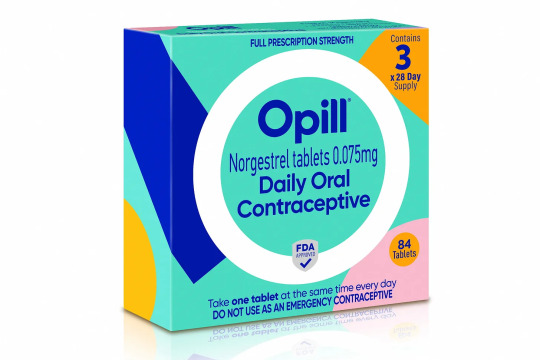
The move could significantly expand access to contraception. The pill is expected to be available in early 2024.
The Food and Drug Administration on Thursday approved a birth control pill to be sold without a prescription for the first time in the United States, a milestone that could significantly expand access to contraception. The medication, called Opill, will become the most effective birth control method available over the counter
5. AIDS can be ended by 2030 with investments in prevention and treatment, UN says
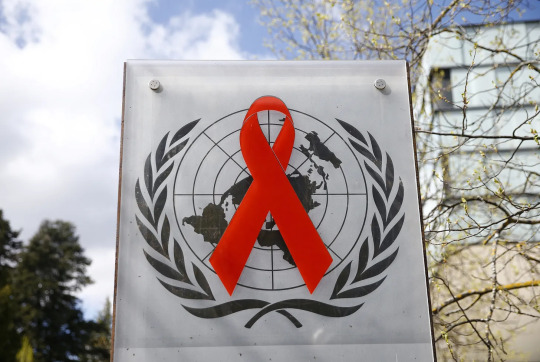
It is possible to end AIDS by 2030 if countries demonstrate the political will to invest in prevention and treatment and adopt non-discriminatory laws, the United Nations said on Thursday.
In 2022, an estimated 39 million people around the world were living with HIV, according to UNAIDS, the United Nations AIDS program. HIV can progress to AIDS if left untreated.
6. Conjoined twins released from Texas Children’s Hospital after successfully separated in complex surgery
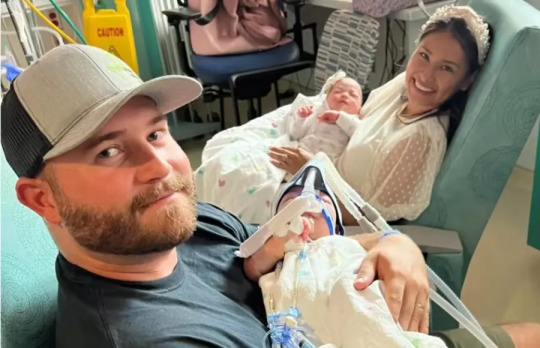
Conjoined twins are finally going home after the pair was safely separated during a complex surgery at Texas Children’s Hospital in June.
Ella Grace and Eliza Faith Fuller were in the neonatal intensive care unit (NICU) for over four months after their birth on March 1. A large team of healthcare workers took six hours to complete the surgery on June 14. Seven surgeons, four anesthesiologists, four surgical nurses and two surgical technicians assisted with the procedure.
7. From villains to valued: Canadians show overwhelming support for wolves

Despite their record in popular culture, according to a recent survey, seven in 10 Canadians say they have a “very positive” view of the iconic predators.
Here's a fascinating video about how wolves changed Yellowstone nat'l park:
youtube
----
That's it for this week :)
This newsletter will always be free. If you liked this post you can support me with a small kofi donation:
Support this newsletter ❤️
Also don’t forget to reblog.
1K notes
·
View notes
Text
I saw a post which claimed since Americans are spending unprecedented amounts of money on holiday gifts this year [1][2]...
the American public isn't actually as strapped for cash as we say or think we are, and
Americans didn’t vote for Trump out of economic frustration.
Like.
I hope you guys know Americans aren't splurging on gifts because we can afford to do so.
The majority of Americans live paycheck to paycheck [3], and yet vacations are on the rise, with Millennials and Gen Z-ers at the front of the trend. [4][5]
It’s not excess capital. It’s nihilism.[6][7][8]
"If you work hard and save your money, someday you can buy a house/raise a family/retire." So goes the conventional wisdom, now fine viscera under the wheels of an Amazon forklift. Even older generations can't afford to retire these days [9]. You can buy a shed for the price of a master's degree. And how are you supposed to raise a child when your full-time job barely covers your grocery bills?
Knowing they'll never travel as a retiree, people are splurging on plane tickets right out of school. Knowing class mobility is a lottery pull, people are dumping their last few pennies into meme tokens and other get-rich-quick schemes. Knowing they're already saddled with lifelong debt, people are saying "fuck it" and grabbing a shovel—because at this point, what's a car payment on top of every other loan they'll never repay? "Things will keep getting worse anyway."
Americans are spending stupid amounts of money on vacations [10] and extravagant gifts [11], yes—but they're not spending THEIR money. They're spending Klarna's money, and the bank's money, and when the bills come due people aren't paying them. We're all just doing kickflips on our way down the drain.
The question, "How does killing the UnitedHealthCare CEO solve anything?" misses the point. The shooter may have believed he was doing the American people a favor, but I don't think the majority of Americans are cheering on Brian's death because they believe it will manifest universal healthcare. It's just nice to see the rich criminals who profit off our pain suffer for their choices.
Even if the Dems had acknowledged our financial straits (I find Atrioc's video "Slowly, Then All at Once" to be very helpful re: why the numbers look good but nobody can afford to live)...I still don't think Kamala Harris would've won the presidency. Again, Americans don't believe progress is possible anymore—at least not via our current system of government. Extremists are banking on a wholesale descent into anarchy. Your everyday worker is distracting themselves from impending financial implosion with daily Beverages (I'm stopping here to take a sip of my Rockstar energy drink). Hope is a heavy burden. Instead, people keep their eyes on their feet. One day at a time. Sometimes on its way to the brick wall, their speeding car hits a CEO—and sometimes it mows down a crowd of schoolchildren. Sometimes we're all just trashing the bathroom.
That's Donald Trump's presidential win, to me. Let the horse take over the hospital, America declared—why not, if none of us can afford a hospital visit anyway. Let the nation descend into anarchy and fascism—why not, if we never had rights/liberty to begin with.
It's not logical. It's lashing out in pain like a cornered animal.
The rule of law doesn't apply to the wealthy, as emblemized by our incumbent president's 34 felony charges. It punishes the marginalized by design, for the benefit of corrupt institutions. Harris would've given us a chance to get back on our feet...but with her centrist prosecutorial approach, she represents the law. Donald Trump represents chaos. He's a champion of the CEOs who bankrupt and maim and kill us, but as a certifiable toddler with no object permanence and a suitcase full of ketchup packets and nuclear launch codes, he's also a fucking nightmare to babysit around the White House. That's the best some people can hope for in this country: To give their tormentors a headache. To "trigger the libs." To treat their representatives to the smallest taste of their own helplessness and hopelessness and fear and anger and pain.
People do not have money. People do not have hope. People do not have compassion.
I don't feel any sympathy for Trump voters, and I don't mean to minimize the role of bigotry in this election. This country was founded on genocide and slavery, and that legacy still permeates our culture. I only mean to explain—not excuse—some of this group's behavior. It's a trend suffered on all sides of the aisle: Nihilism externalized as sabotage, whether directed at oneself or others. People are so sick of watching this boat sink into the ocean they've set it on fire just to feel like they had a say in it.
80 notes
·
View notes
Text
9 Places You're Most Likely to Catch COVID as Summer Wave Surges - Published Aug 19, 2024
The answer "damn near everywhere people go" may shock you.
COVID’s surge shows no sign of slowing down as the biggest summer wave in two years continues. In fact, COVID levels are “very high” in 27 states, according to the CDC’s wastewater data. “Currently, the COVID-19 wastewater viral activity level is very high nationally, with the highest levels in the Western US region,” Dr. Jonathan Yoder, deputy director of the CDC’s Wastewater Surveillance Program, said to CNN. “This year’s COVID-19 wave is coming earlier than last year, which occurred in late August/early September.” Fortunately, death rates and hospitalization rates are nothing like they were during previous waves due to greater immunity and vaccines. But catching COVID still comes with risks, including LONG COVID, which can result in chronic, debilitating illness. So how do you stay safe? Use caution before entering these nine places you’re most likely to catch COVID now, as the summer wave surges.
Crowded indoor events COVID spreads primarily through respiratory droplets when an infected person coughs, sneezes, talks, or breathes, especially in close-contact settings or poorly ventilated areas. “People who are higher risk for getting very sick from COVID-19 should consider taking extra precautions for the next few weeks, like limiting time in crowded indoor settings or wearing a mask in crowded indoor settings. People rarely get COVID-19 outdoors, so outdoor events remain quite safe,” say the experts at the Tacoma-Pierce County Health Department.
Airports, airplanes and public transportation Given the COVID rates right now, the CDC urges travelers to “get up to date with your COVID-19 vaccines before you travel and take steps to protect yourself and others. Consider wearing a mask in crowded or poorly ventilated indoor areas, including on public transportation and in transportation hubs. Take additional precautions if you were recently exposed to a person with COVID-19. Don’t travel while sick.” They go even further for certain folks: “If you have a weakened immune system or are at increased risk for severe disease, talk to a healthcare professional before you decide to travel. If you travel, take multiple prevention steps to provide additional layers of protection from COVID-19, even if you are up to date with your COVID-19 vaccines. These include improving ventilation and spending more time outdoors, avoiding sick people, getting tested for COVID-19 if you develop symptoms, staying home if you have or think you have COVID-19, and seeking treatment if you have COVID-19.”
Shopping malls Studies are just now coming out with an analysis of what happened during the height of the pandemic. Although times are different now, these results can be instructive. For example, one study published in April 2024 “examines the transmission of COVID-19 through casual contact in retail stores using data from Denmark. By matching card payment data with COVID-19 test results, researchers tracked over 100,000 instances where infected individuals made purchases in stores. They found that customers exposed to an infected person in the same store within a 5-minute window had a significantly higher infection rate in the following week. The study concludes that retail store transmissions contributed notably to the spread of COVID-19, particularly during the period when the Omicron variant was dominant.”
Religious gatherings The transmission of the SARS-CoV-2 virus during religious events has nothing to do with religion and everything to do with a communal gathering in which people, well, commune. “The smallest SARS-CoV-2 droplets can remain airborne and travel farther than six feet. The scientific community does not agree upon what is a ‘safe distance,’ but standing near an infectious person is riskier than standing farther away,” says the AMA. Additionally, “the amount of virus a person is exposed to can influence the chance of infection and the severity; consequently, staying in one place for a longer time creates a higher risk of infection.”
Movie theaters The box office is back, as hits like Deadpool & Wolverine, It Ends With Us, and Alien: Romulus pack them in after a few dark pandemic years of low attendance, the rare Barbenheimer proving the exception to the rule. For movie buffs, it’s a thrill. But check your theater’s ventilation before lining up around the block. One study published this year “investigates the risk factors for COVID-19 transmission during an outbreak in a movie theater in Incheon, South Korea, in November 2021. It involved 48 confirmed cases, primarily among theater attendees, with a high attack rate of 84.8% during one screening. The study found that inadequate ventilation and close proximity among audience members were key contributors to the spread of the virus despite most attendees being fully vaccinated. The study emphasizes the importance of proper ventilation in enclosed spaces like theaters to prevent airborne transmission of COVID-19.”
Healthcare facilities “Some hospitals across the United States are reinstating indoor masking rules amid rising cases and hospitalizations of respiratory illnesses including COVID-19 and influenza,” reported ABC News earlier this year. "Ultimately, health systems, hospitals, places that deliver care are going to see some of the most vulnerable and at-risk individuals -- many, with underlying conditions," Dr. John Brownstein, an epidemiologist and chief innovation officer at Boston Children's Hospital and an ABC News contributor, told the network. "Those are especially the places where we want to protect individuals, and so when we have this rapid rise in respiratory illness, those are going to be the first places to try to use measures to reduce chances of transmission, both to protect patients, those receiving care, as well as workforce."
Gyms and fitness studios Common sense will tell you transmission of an airborne disease may increase the more frequently people breathe in and out—as you might do at the gym. One “study looked at the number of aerosol particles 16 people exhaled at rest and during workouts. These tiny bits of airborne matter — measuring barely a few hundred micrometers in diameter, or about the width of a strand of hair, and suspended in mist from our lungs — can transmit coronavirus if someone is infected, ferrying the virus lightly through the air from one pair of lungs to another,” reported the New York Times during the pandemic. “The study found that, at rest, the men and women breathed out about 500 particles per minute. But when they exercised, that total soared 132-fold, topping out above 76,000 particles per minute, on average, during the most strenuous exertion.”
Bars and Nightclubs Just when some of us wanted to drink the most, bars were verboten during the height of the pandemic. There was a good reason to use caution. One study published last year “analyzed over 44,000 COVID-19 cases in Tokyo in 2020, focusing on transmission in various settings, including healthcare and nightlife venues like bars and nightclubs. It found that nightlife settings were more likely to involve clusters of five or more infections and were more likely to lead to further spread compared to other settings. The highest case-fatality rate was observed in healthcare settings. The findings suggest that targeting interventions in nightlife venues could be crucial for controlling COVID-19 transmission, especially during the early stages of an outbreak.”
Restaurants and cafés Last year, the Washington Post asked virus experts if they’d eat in restaurants. Joanna Dolgoff, a pediatrician and spokesperson for the American Academy of Pediatrics, offered an answer that may be a decent North Star for you today. “At this time, I will continue to eat in restaurants as long as they are well-ventilated and not overly crowded. If somebody near me shows signs of illness, I will be prepared to leave immediately. If covid cases continue to spike and if illness becomes more severe, I will stop eating inside restaurants until cases subside,” she said.
#covid#mask up#pandemic#covid 19#wear a mask#coronavirus#sars cov 2#still coviding#public health#wear a respirator
83 notes
·
View notes
Text
United Healthcare, specifically through its subsidiary ‘Change Healthcare’, experienced significant ransomware attacks in 2024. Here's a summary based on the available information:
Cyberattack Details: Change Healthcare, a unit of UnitedHealth Group's Optum division, was hit by a ransomware attack on February 21, 2024. The attack was attributed to a Russian-speaking ransomware gang known as ALPHV or Blackcat. This group claimed to have stolen over six terabytes of sensitive data, including medical records.
The Impact: The attack led to widespread disruptions in the U.S. healthcare system, affecting pharmacies, hospitals, and other medical providers by preventing them from processing claims and receiving payments. This caused significant operational and financial chaos.
Financial Impact: The immediate aftermath of the attack was reported to cost UnitedHealth around $872 million in the first quarter, not including potential ransom payments. However, the total financial impact was projected to be between $1.3 billion and $1.6 billion for the year.
Ransom Payment: There were reports and confirmations that UnitedHealth paid a ransom of $22 million in Bitcoin to the attackers, with the aim of protecting patient data from being disclosed.
Data Breach: The breach potentially compromised the personal and health information of over 100 million individuals, making it one of the largest breaches in healthcare history.
Investigations and Response: The U.S. Department of Health and Human Services launched an investigation due to the magnitude of the incident. UnitedHealth has been working with law enforcement and cybersecurity experts to investigate the breach and restore systems. They've also provided temporary funding assistance to affected healthcare providers. 🤔
#pay attention#educate yourselves#educate yourself#reeducate yourselves#knowledge is power#reeducate yourself#think about it#think for yourselves#think for yourself#do your homework#do research#do some research#do your own research#ask yourself questions#question everything#government corruption#evil lives here#news
29 notes
·
View notes
Text
"This is an immediate crisis for kids, for public safety, for our seniors, for our healthcare system," said Sen. Chris Murphy. "And why? Because Donald Trump is trying to seize power."
27 notes
·
View notes
Text
The concept of insurance, of any kind of insurance, is a scam.
It relies on the fact that they pay out less than they receive. For example, with car insurance, in most cases, if you were to hit a car, you could pay out the other the same amount as your insurance without even getting close to what you pay annually. There is no way to make profit fairly as an insurance company. A savings account, if it werent for insurance often being mandatory, would literally be a better deal.
When this is applied to life saving care, it becomes a for-profit-human-slaughterhouse. The monthly payments have no relation to the payouts. The only difference is that they are leveraging healthy people’s contribution to pay for those people who somehow do get more care than theyve paid for approved, but the bottom line is that SOMEONE is paying for it, a ceo is getting paid to do it, and the money is getting all shuffled around to make it work.
In a tax based healthcare system, the only thing that leaves the model is the ceo. People pay in, now through taxes instead of standard prices set by one man or a group of them, money is moved around to support the sick while the healthy still pay in, just like normal healthcare now, only there’s not a leach at the top sucking all the money out of the system.
When people who oppose universal healthcare say “well someone’s gotta pay for it!” They dont realize that they are already paying for someone’s healthcare if they are paying in more than they use their insurance(likely) and if they use their insurance more than they pay in THEN SOMEONE ELSE IS ALREADY FUNDING THEIR HEALTHCARE.
Literally the system is already ready. We just need to remove one stumbling block from the set-up and we’ll be good to go, from all forms of insurance but health insurance first and foremost! Now that the public can see theyre unified in this goal, hopefully we can remove these leaches for good, and not in a hydra-like fashion where another one instantly pops up.
20 notes
·
View notes
Text
Oulu is five hours north from Helsinki by train and a good deal colder and darker each winter than the Finnish capital. From November to March its 220,000 residents are lucky to see daylight for a couple of hours a day and temperatures can reach the minus 30s. However, this is not the reason I sense a darkening of the Finnish dream that brought me here six years ago.
In 2018, moving to Finland seemed like a no-brainer. One year earlier I had met my Finnish partner while working away in Oulu. My adopted home of Italy, where I had lived for 10 years, had recently elected a coalition government with the far-right Matteo Salvini as interior minister, while my native UK had voted for Brexit. Given Finland’s status as a beacon of progressive values, I boarded a plane, leaving my lecturing job and friends behind.
Things have gone well. My partner and I both have stable teaching contracts, me at a university where my mostly Finnish colleagues are on the whole friendlier than the taciturn cliche that persists of Finns (and which stands in puzzling contradiction to their status as the world’s happiest people).
Notwithstanding this, I feel a sense of unease as Finland’s prime minister Petteri Orpo’s rightwing coalition government has set about slashing welfare and capping public sector pay. Even on two teachers’ salaries my partner and I have felt the sting of inflation as goods have increased by 20% in three years. With beer now costing €8 or more in a city centre pub, going out becomes an ever rarer expense.
Those worse off than us face food scarcity. A survey conducted by the National Institute for Health and Welfare found 25% of students struggling to afford food, while reductions in housing benefit mean tenants are being forced to move or absorb the shortfall in rent payments. There are concerns that many unemployed young people could become homeless.
Healthcare is faring little better. Finland’s two-tier system means that while civil servants and local government employees (including teachers) paradoxically enjoy private health cover, many other people face long waiting lists. Not having dental cover on my university’s plan, I called for a public dental appointment in April. I was put on callback and received a text message stating I’d be contacted when the waiting list reopened. Six months later, I am still waiting. A few years ago I could expect to wait two months at most.
The current government, formed by Orpo’s National Coalition party (NCP) last year in coalition with the far-right Finns party, the Swedish People’s party of Finland and the Christian Democrats, has been described as “the most rightwing” Finland has ever seen – a position it appears to relish.
Deputy prime minister and finance minister Riikka Purra – the Finns’ party leader – has been linked to racist and sometimes violent comments made online back in 2008. The party’s xenophobia is clearly influencing policymaking and affecting migrants. As a foreigner, I’d be lying if I didn’t admit to feeling a certain chill as anti-immigrant rhetoric ramps up.
A survey by the organisation Specialists in Finland last year found that most highly qualified workers would consider leaving Finland if the government’s planned tightening of visa requirements went ahead (that proposal, which extended residence time required for Finnish citizenship from four to as many as eight years has now become law). Luckily, I am a permanent resident under the Brexit agreement.
With the coalition intent on ending Finland’s long history of welfarism in just one term, there is a risk (and hope among progressives) that it may go too far, inviting a backlash. We arguably saw signs of this in the European election in the summer, when Li Andersson won the highest number of votes for an EU election candidate in Finland. Andersson, who was education minister in Sanna Marin’s former centre-left coalition government (which lost to the NCP in April 2023), ran on a progressive red-green ticket of increased wealth equality and measures to tackle the climate crisis. She has also been critical of emergency laws blocking asylum seekers from crossing Finland’s eastern border, arguing that it contravenes human rights obligations.
Andersson’s party, the Left Alliance, chose a new leader this month, the charismatic feminist author Minja Koskela, who was elected to Helsinki’s council in 2021 after a period as secretary of the Feminist party, and as a member of parliament in 2023. Koskela argues: “People are widely frustrated with the government’s discriminatory policy and cuts to culture, social and health services, education and people’s livelihood. It is possible to turn this frustration into action.” (Full disclosure: I’m a member of the party and have helped coordinate its local approach to immigrants.)
It remains to be seen if she can build on Andersson’s EU success. Although the popular media-savvy figure appears to relish the challenge of turning the party into an election winner, Koskela faces a huge challenge. The party struggles to poll at more than 10% nationally, aside from a brief high of 11% in July. A place in government is nonetheless possible. But Marin’s Social Democratic party (SDP) of Finland (now led by Antti Lindtman), has topped the national opinion polls 12 out of 14 times since April 2023.
Meanwhile, the Finns party is polling at 16%, down from the 20.1% vote they gained in the election. These figures point to one thing: another possible SDP-led coalition government in the next parliament by the summer of 2027. This would probably include the Left Alliance and the Green League, among others. And such a coalition would aim to undo a lot of the damage done by the right.
But until then, there will be more damage to come. So while there is clearly hope for an end in sight to the country’s political darkness three years hence, this will bring little solace now to poor people, migrants, and the squeezed middle class as the long Finnish winter closes in.
24 notes
·
View notes